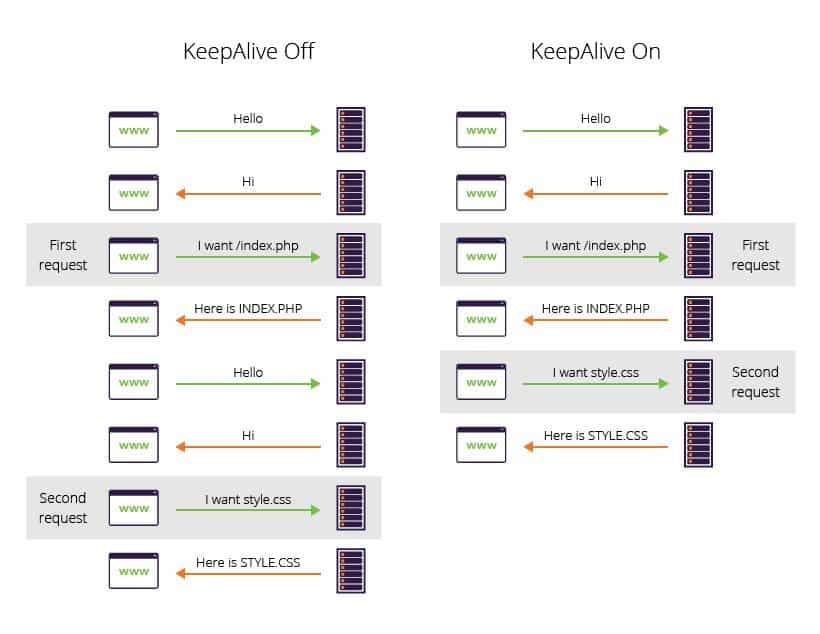Have you ever wondered what makes your web browsing experience smooth and efficient? One key player behind the scenes is the Keepalives mechanism in HTTP 1.1.
This article delves into the intricacies of Keepalives, shedding light on how this essential feature optimizes your internet interactions. We will explore its functionality within HTTP 1.1, demonstrate its role in the web page request-response cycle, and examine its impact on modern web browsing. Join us as we uncover the secrets of Keepalives and their pivotal role in the digital world.
In this article:
- Understanding Keepalives in HTTP
- Keepalives in Action
- Advantages of Using Keepalives
- Limitations and Considerations
- Minimizing Connections in HTTP/2
- References

1. Understanding Keepalives in HTTP
Keepalives is a feature of Hypertext Transfer Protocol (HTTP) version 1.1 that minimizes the number of connections that Web browsers need to make to access content on Web servers.
Keepalives in HTTP 1.1 are a fundamental mechanism designed to enhance network efficiency. They allow a single TCP connection to be used for multiple HTTP requests and responses, rather than opening a new connection for each transaction. This feature reduces the overhead of establishing and closing connections, which is especially beneficial in HTTP 1.1 where each request otherwise requires a separate connection. By maintaining a persistent connection, Keepalives minimizes latency and resource consumption, leading to faster web page loading times and a more efficient use of network resources.
2. Keepalives in Action
During a typical web page request and response cycle, Keepalives play a critical role. When you click on a link or type in a URL, your browser sends an HTTP request to the server. With Keepalives enabled, instead of closing the connection after receiving the response, the connection remains open for a predetermined period. This allows subsequent requests to the same server to reuse the existing connection. The result is a more seamless and quicker browsing experience, as the time-consuming process of establishing new connections for each request is avoided. Keepalives ensure that your interaction with websites is not just about fetching data, but doing so in the most efficient way possible.
Mechanics
When a Web browser that supports keepalives (such as Internet Explorer 4 and above) makes an HTTP GET request to a Web server that supports keepalives (such as IIS 4 and above), the Web browser includes a new “Connection:Keep-Alive” header in the list of HTTP headers that it sends to the Web server in the request.

The Web server responds by giving the client the file it requested (usually an HTML page or an image file). After the server sends the file to the client, instead of closing the TCP/IP socket it keeps the socket open for a period of time in case the client wants to download additional files.
A typical Web page might include a dozen images, and normally up to four sockets are kept open for transferring files between the client and the server.
Keepalives other usages
The term “keepalives” also refers to special packets used to keep a TCP connection open on a TCP/IP internetwork.
Keepalives support
Keepalives do not work unless they are supported by both the Web browser and the Web server.
3. Advantages of Using Keepalives
Keepalives in HTTP 1.1 significantly enhance connection efficiency and resource management. By maintaining a persistent connection for multiple requests, they reduce the need for frequent handshakes associated with opening and closing connections. This results in less latency and quicker data transfer, leading to faster page load times. Efficient connection reuse also means reduced CPU and memory usage on both client and server sides, optimizing overall system performance. Furthermore, Keepalives reduce network congestion, making them beneficial for both high-traffic websites and users with limited bandwidth.
4. Limitations and Considerations
While beneficial, Keepalives have limitations. One major drawback is the potential for connections to remain open longer than necessary, consuming server resources. In high-traffic scenarios, this can lead to resource exhaustion, impacting server performance. Additionally, Keepalives may not be ideal in scenarios where connections are intermittent or when the server needs to handle a large number of short-lived connections. They also add complexity to server configuration and management, requiring careful tuning to balance performance with resource utilization.
5. Minimizing Connections in HTTP/2
HTTP/2 introduces more advanced connection management features, building upon the concept of Keepalives. It allows multiple requests and responses to be multiplexed over a single connection, significantly reducing the number of connections needed. This is achieved through its ‘stream’ concept, where numerous streams can coexist, each carrying a request-response pair, without blocking each other. While HTTP/2 enhances connection efficiency, Keepalives remains relevant, particularly in environments where legacy systems are in use or in specific server configurations that do not support HTTP/2. Its role in maintaining connection efficiency, especially in HTTP 1.1 environments, continues to be crucial.
6. References
- “HTTP: The Definitive Guide” by David Gourley and Brian Totty.
- “High Performance Browser Networking” by Ilya Grigorik.
- RFC 2616: Hypertext Transfer Protocol — HTTP/1.1.
- RFC 7540: Hypertext Transfer Protocol Version 2 (HTTP/2).
- “Computer Networking: A Top-Down Approach” by James Kurose and Keith Ross.
- “TCP/IP Illustrated, Volume 1: The Protocols” by W. Richard Stevens.